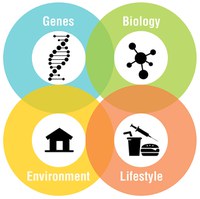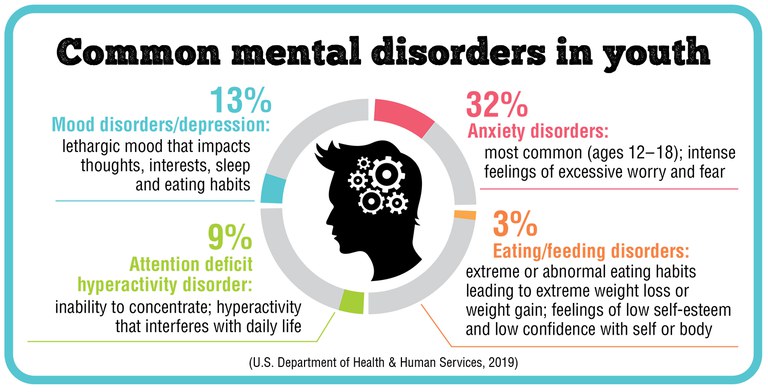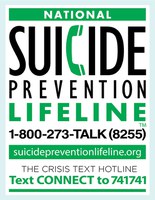Youth Mental Health: How Adults Can Prevent, Recognize and Intervene with Mental Disorders (YD1990, Sept. 2020)
Availability: Web only

What is mental health:
emotional, psychological and social well-being
● It affects how we think, feel and act.
● It is the interaction among genes, environment, biology and lifestyle.
● It impacts how we cope with life events, interact
with others and make life choices.
● Remember that this is an American culture’s interpretation of mental health.
(Gopalkrishnan, 2018; Mental Health, 2019)
Mental disorders:
More common than you think
Mental disorders are mental health conditions with abnormalities in our ability to effectively think, act and share emotions.
● 1 in 5 youth ages 9 to 17 has a mental disorder that causes some degree of impairment.
● Only 1/3 of these adolescents has received necessary treatment.
● 1 in 10 adolescents has a disorder that causes significant impairment.
● Suicide is the second leading cause of death in young people ages 15 to 24.
(CDC, 2020)
Risk factors for youth
Here are a few factors that put youth more at risk for developing a mental disorder:
- Bullying/cyberbullying and social exclusion
- Gender differences/gender identity issues
- Issues with sleeping
- Low self-esteem
- Fluctuating hormones (puberty)
- Trauma
- High-stress environmental factors such as poverty, unsafe living conditions or family conflict
(National Research Council and Institute of Medicine, 2009)
Warning signs to look for
Consider the youth’s life holistically before assuming these warning signs are due to a mental disorder.
✖ Sleeping too much or not enough
✖ Extreme weight gain or weight loss
✖ Irritable or detached mood for a majority of the day
✖ Feelings of worthlessness or hopelessness
✖ Avoidance of social situations and withdrawing
✖ Use of drugs or alcohol
✖ Extremely low self-concept and self-esteem
(American Academy of Pediatrics, 2012)
Normal vs. abnormal emotional development
While some things youth say or do might seem “abnormal” to adults, many are considered part of normal emotional development.
“Normal” behaviors: increased expression of emotions, spending less time with family, concerns about body image, high personal expectations, regression of behavior for days at a time, expressing interest in opposite sex (or same sex), testing parental rules/limits, contemplation of experimentation with drugs/alcohol
“Abnormal” behaviors: unhealthy coping strategies (self-harm, induced vomiting, suppressing emotions, hurting others), excessive and constant moodiness, extreme behaviors and emotions, any of the warning signs lasting a majority of the time and consistent across contexts and situations
If your youth exhibits behaviors that are considered abnormal, contact a mental health specialist for more assistance.
(Mental Health America, n.d.)
Cultural considerations
● The definition of mental health and diagnosis of mental disorders may differ across cultures, races, ethnicities, families, personal identities, etc.
● Accessibility to mental health services is vastly different across cultures and communities.
● Never assume someone has a similar view of mental health. If you are unsure, ask what mental health means to that person.
● Consider cultural differences when observing mental health concerns. Is the behavior considered normal in another culture?
● Always be culturally aware. You do not need to learn every culture, but be empathetic to the idea that every culture is different while celebrating diversity.
(Gopalkrishnan, 2018)
Immediate suicide intervention techniques
If you notice any signs of suicidal thoughts or ideation, follow these steps for how you can be prepared to help:
● Do not leave the student/child alone. Get them to a safe and private environment while remaining calm.
● Always contact the school mental health professional or a local mental health professional if at home. Contact the emergency suicide hotline (1-800-273-8255) if the risk for suicide is high.
● Ask them if they have immediate thoughts of harming themselves. Remove necessary items that might be an immediate risk for self-harm.
● Express your care and concern for them and listen nonjudgmentally. If they are unwilling/unable to talk, sit and wait quietly for help.
● While you wait, provide them with resources and ensure them you will assist in getting the help they need. Resources are listed at the end of this publication.
● After the incident, follow up. Show that you will continue to be there for them.
(American Foundation for Suicide Prevention, 2018)
Promoting positive mental health in schools and communities
● Be an advocate for mental health and set a good example by taking care of your own mental health.
● Create a positive and supportive environment for youth with mental disorders to feel validated. Mental health is real and it is important to discuss. Make talking about mental health a normal and open conversation.
● Provide safety and security by creating a safety plan. (ex: Where to go when they are having an anxiety attack.)
● Educate others about the prevalence of mental disorders and the importance of promoting positive mental health in youth.
● Help youth practice healthy coping skills and continue to educate on ways they can improve their mental health.
● Promote physical well-being along with mental health (exercise, healthful eating, sleep, limiting screen time).
● Being aware and able to recognize signs that youth are struggling is important in ensuring they get adequate help and support immediately.
(American Academy of Pediatrics, 2018; National Association of School Psychologists, 2017)
Effective youth coping strategies
- Exercise regularly and eat balanced meals.
- Get a recommended 7 to 8 hours of sleep each night.
- Avoid using drugs and alcohol and drinking excess caffeine.
- Learn and practice relaxation, mindfulness and breathing techniques.
- Replace negative self-talk with positive self-talk by utilizing a reframing technique.
- Take breaks from stressful situations when necessary, especially from social media.
- Build a firm support system of friends, family, peers, teachers, etc. Reach out when you need help or feel alone.
- Identify tasks or hobbies that make you happy and schedule time to do them regularly.
(American Academy of Child & Adolescent Psychiatry, 2019)
Youth mental health resources:
● National Suicide Prevention Lifeline number: 1-800-273-8255 (TALK)
● National Institute of Mental Health: Child and Adolescent Mental Health
● NDSU References and Resources for Addressing Youth Issues Publication
Apps for youth to promote mental health:
● Calm: Mindfulness, meditation, breathing exercises
● Happify: Good-mood training program
● Daylio: Mood tracker and journal

References:
American Academy of Child & Adolescent Psychiatry. (2019). Stress management and teens. www.aacap.org/AACAP/Families_and_Youth/Facts_for_Families/FFF-Guide/Helping-Teenagers-With-Stress-066.aspx
American Academy of Pediatrics. (2012). Mental health and teens: Watch for danger signs. www.healthychildren.org/English/ages-stages/teen/Pages/Mental-Health-and-Teens-Watch-for-Danger-Signs.aspx
American Academy of Pediatrics. (2018). Adolescent depression: What parents can do to help. www.healthychildren.org/English/health-issues/conditions/emotional-problems/Pages/Childhood-Depression-What-Parents-Can-Do-To-Help.aspx
American Foundation for Suicide Prevention. (2018). After a suicide: A toolkit for schools (2nd Ed.). http://www.sprc.org/sites/default/files/resource-program/AfteraSuicideToolkitforSchools.pdf
Centers for Disease Control and Prevention (CDC). (2020). Data and statistics on children’s mental health. www.cdc.gov/childrensmentalhealth/data.html
Gopalkrishnan, N. (2018). Cultural diversity and mental health: Considerations for policy and practice. Front Public Health, 6 (179), 1-7. https://doi.org/10.3389/fpubh.2018.00179
Mental Health. (2019). What is mental health? www.mentalhealth.gov/basics/what-is-mental-health
Mental Health America. (n.d.). Healthy mental and emotional development. https://www.mhanational.org/sites/default/files/BACK%20TO%20SCHOOL%202014%20-%20Healthy%20Mental%20and%20Emotional%20Development.pdf
National Association of School Psychologists. (2017). Supporting children’s mental health: Tips for parents and educators. www.nasponline.org/resources-and-publications/resources-and-podcasts/mental-health/prevention-and-wellness-
promotion/supporting-childrens-mental-health-tips-for-parents-and-educators
National Research Council and Institute of Medicine. (2009). Preventing mental, emotional, and behavioral disorders among young people: Progress and possibilities (M. E. O’Connell, T. Boat, & K. E. Warner, Eds.). The National Academies Press. https://doi.org/10.17226/12480
U.S. Department of Health & Human Services. (2019). Adolescent health. www.hhs.gov/ash/oah/adolescent-development/mental-health/adolescent-mental-health-basics/common-disorders/index.html
Reviewed by: Extension Agents Holly Johnson, Caroline Homan, Emily Goff, Susan Milender; Extension Family
Science Specialist Kim Bushaw; Mental Health Specialists Dr. Brenda Hall, Dr. Todd Lewis, Dr. Jill Nelson
NDSU Extension does not endorse commercial products or companies even though reference may be made to tradenames, trademarks or service names. NDSU encourages you to use and share this content, but please do so under the conditions of our Creative Commons license. You may copy, distribute, transmit and adapt this work as long as you give full attribution, don’t use the work for commercial purposes and share your resulting work similarly. For more information, visit www.ag.ndsu.edu/agcomm/creative-commons.
County commissions, North Dakota State University and U.S. Department of Agriculture cooperating. NDSU does not discriminate in its programs and activities on the basis of age, color, gender expression/identity, genetic information, marital status, national origin, participation in lawful off-campus activity, physical or mental disability, pregnancy, public assistance status, race, religion, sex, sexual orientation, spousal relationship to current employee, or veteran status, as applicable. Direct inquiries to Vice Provost for Title IX/ADA Coordinator, Old Main 201, NDSU Main Campus, 701-231-7708, ndsu.eoaa@ndsu.edu. This publication will be made available in alternative formats for people with disabilities upon request, 701-231-7881.





